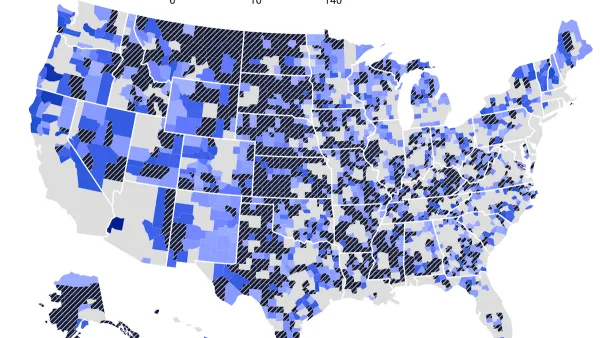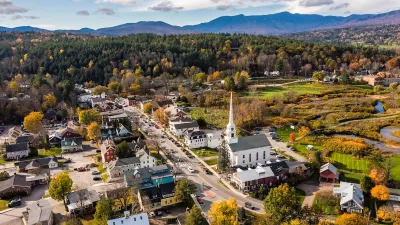Come November, 11 of Colorado's 64 counties, mostly in northeast, will vote to form a new state. Jack Healy explores what's behind the 51st State Initiative, what set it off, as well as other secession movements, mostly by rural areas in the U.S.
Seven additional counties could possibly join the movement, according to the map of The 51st State Initiative. If not secession, two alternative goals would be additional representation in the state senate or annexation by Wyoming.
Secession movements are hardly new - see our Sept. 6 post of the latest development in the long-standing effort to form the state of Jefferson in northern California and southern Oregon and NPR's "Beyond 50: American States That Might Have Been" on Michael J. Trinklein's book on the topic. The last successful effort resulted in the formation of West Virginia in 1863, writes Healy.
While the break-away movement to form "New Colorado" has been simmering for a long time, it was the recent gun regulations prompted by the mass shootings last year in an Aurora, Colo. movie theater and a Newton, Conn. school, the same ones that caused a successful recall last month of two state senators, that truly inspired it.
Urban-rural, liberal-conservative divides lie at the heart of the secession movement, yet there are glaring inconsistencies. Healy quotes Lyle Miller, who owns the convenience store in Cheyenne Wells where he wrote the article.
"I would’ve never believed the state of Colorado would become this liberal. I’m afraid for my grandchildren. I want them to have the same heritage I had".
Healy points to demographic statistics that indicate that Miller's grandchildren are more likely to leave Cheyenne County than stay, with the population reduced almost 50% from it's peak of 3,700 people, notwithstanding the low unemployment rate of 3.9 percent in the county due to thriving agriculture and oil fields.
The last two decades have brought sharp population declines as children moved away and the descendants of homesteading families died off. The county’s population is now 1,870, about one resident per square mile.
Jeffrey Hare, a leader of the 51st State Initiative, states, "What we’re attempting to do is restore liberty. People think this is a radical idea,” he said. Yet recent state laws that have increased liberty, such as legalizing marijuana and gay civil unions do not appear to be welcomed changes.
Should the votes succeed, two additional hurdles would await. "(T)he state must then vote to allow them to leave. After that, Congress would have to agree to admit a new state", writes Healy. However, the movement appears to be reaping political gains as Democratic governor, John W. Hickenlooper, who runs for reelection next year, "has already vowed to chart a more moderate course when the legislature comes back into session," writes Healy.
UPDATE (11/19/2013): In five of the 11 counties where a measure to secede from Colorado was on the Nov. 5 ballot, voters said "yes"; the remaining six voted 'no'. The urban-rural divide was as the heart of the "51st State Initiative". The ballot results are described in greater detail here by Monte Whaley of The Denver Post.
FULL STORY: Fed Up on the Prairie, and Voting on Seceding From Colorado

Planetizen Federal Action Tracker
A weekly monitor of how Trump’s orders and actions are impacting planners and planning in America.

Maui's Vacation Rental Debate Turns Ugly
Verbal attacks, misinformation campaigns and fistfights plague a high-stakes debate to convert thousands of vacation rentals into long-term housing.

Restaurant Patios Were a Pandemic Win — Why Were They so Hard to Keep?
Social distancing requirements and changes in travel patterns prompted cities to pilot new uses for street and sidewalk space. Then it got complicated.

In California Battle of Housing vs. Environment, Housing Just Won
A new state law significantly limits the power of CEQA, an environmental review law that served as a powerful tool for blocking new development.

Boulder Eliminates Parking Minimums Citywide
Officials estimate the cost of building a single underground parking space at up to $100,000.

Orange County, Florida Adopts Largest US “Sprawl Repair” Code
The ‘Orange Code’ seeks to rectify decades of sprawl-inducing, car-oriented development.
Urban Design for Planners 1: Software Tools
This six-course series explores essential urban design concepts using open source software and equips planners with the tools they need to participate fully in the urban design process.
Planning for Universal Design
Learn the tools for implementing Universal Design in planning regulations.
Heyer Gruel & Associates PA
JM Goldson LLC
Custer County Colorado
City of Camden Redevelopment Agency
City of Astoria
Transportation Research & Education Center (TREC) at Portland State University
Jefferson Parish Government
Camden Redevelopment Agency
City of Claremont





























